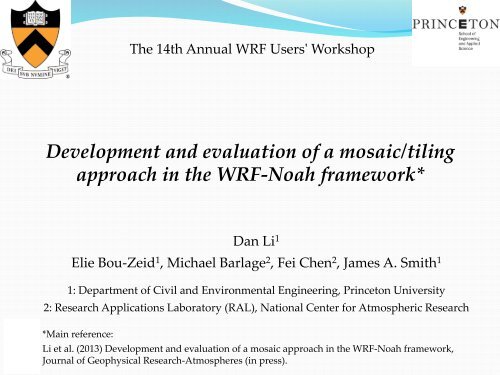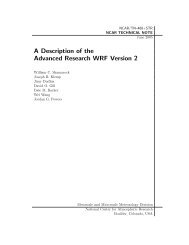Development and evaluation of a mosaic/tiling approach in ... - MMM
Development and evaluation of a mosaic/tiling approach in ... - MMM
Development and evaluation of a mosaic/tiling approach in ... - MMM
Create successful ePaper yourself
Turn your PDF publications into a flip-book with our unique Google optimized e-Paper software.
The 14th Annual WRF Users'ʹ Workshop <br />
<strong>Development</strong> <strong>and</strong> <strong>evaluation</strong> <strong>of</strong> a <strong>mosaic</strong>/<strong>til<strong>in</strong>g</strong><br />
<strong>approach</strong> <strong>in</strong> the WRF-‐‐Noah framework*<br />
Dan Li 1 <br />
Elie Bou-‐‐Zeid 1 , Michael Barlage 2 , Fei Chen 2 , James A. Smith 1 <br />
1: Department <strong>of</strong> Civil <strong>and</strong> Environmental Eng<strong>in</strong>eer<strong>in</strong>g, Pr<strong>in</strong>ceton University <br />
2: Research Applications Laboratory (RAL), National Center for Atmospheric Research <br />
*Ma<strong>in</strong> reference:<br />
Li et al. (2013) <strong>Development</strong> <strong>and</strong> <strong>evaluation</strong> <strong>of</strong> a <strong>mosaic</strong> <strong>approach</strong> <strong>in</strong> the WRF-‐‐Noah framework,<br />
Journal <strong>of</strong> Geophysical Research-‐‐Atmospheres (<strong>in</strong> press).
Outl<strong>in</strong>e <br />
@ Introduction to the <strong>mosaic</strong>/<strong>til<strong>in</strong>g</strong> <strong>approach</strong> <br />
@ Evaluation aga<strong>in</strong>st observations <br />
§<br />
§<br />
Case 1: a clear day, 2009-‐‐07-‐‐14 <br />
Case 2: a ra<strong>in</strong>fall period, 2008-‐‐07-‐‐21 to 2008-‐‐07-‐‐27 <br />
@ Conclusions<br />
2
Real World: mul1ple “1les” with<strong>in</strong> a “grid cell” <br />
dx <br />
Urban <br />
27%<br />
Forest <br />
9%<br />
dy <br />
Wetl<strong>and</strong> <br />
4%<br />
Grassl<strong>and</strong> <br />
54%<br />
Water 6%<br />
3
Modell<strong>in</strong>g World: dom<strong>in</strong>ant vs <strong>mosaic</strong> <br />
WRF-‐Noah <br />
WRF-‐Noah-<strong>mosaic</strong><br />
(N=3) <br />
Urban <br />
30% <br />
Forest <br />
10% <br />
Grassl<strong>and</strong> 100% <br />
Grassl<strong>and</strong> 60% <br />
4
Hypothesis <br />
@ Urban environments provide a good test bed for this<br />
<strong>mosaic</strong>/<strong>til<strong>in</strong>g</strong> <strong>approach</strong> due to the considerable surface<br />
heterogeneities <strong>and</strong> the substantial differences between<br />
different surface types (e.g., impervious surface <strong>and</strong><br />
vegetated surface). <br />
@ Despite that high-‐‐resolution (~1–3 km) numerical<br />
simulations are usually conducted <strong>in</strong> urban<br />
environments, the sub-‐‐grid scale variability <strong>of</strong> l<strong>and</strong><br />
surface characteristics rema<strong>in</strong>s important.<br />
5
Doma<strong>in</strong> configura1on <br />
@<br />
NLCD2006: 30 m resolution, 3 urban categories <br />
6
WRF other physics <strong>and</strong> forc<strong>in</strong>g <br />
@ the Rapid Radiative Transfer Model (RRTM) scheme for<br />
longwave radiation <br />
@ the Dudhia scheme for shortwave radiation <br />
@ the 2D Smagor<strong>in</strong>sky scheme for horizontal diffusion <br />
@ the Mellor-‐‐Yamada-‐‐Janjic planetary boundary layer<br />
scheme <br />
@ the WSM-‐‐6 scheme for microphysics<br />
@ the S<strong>in</strong>gle-‐‐layer Urban Canopy Model for urban physics <br />
@ North America Regional Reanalysis (NARR) <br />
7
Outl<strong>in</strong>e <br />
@ Introduction to the <strong>mosaic</strong>/<strong>til<strong>in</strong>g</strong> <strong>approach</strong> <br />
@ Evaluation aga<strong>in</strong>st observations <br />
§<br />
§<br />
Case 1: a clear day, 2009-‐‐07-‐‐14 <br />
Case 2: a ra<strong>in</strong>fall period, 2008-‐‐07-‐‐21 to 2008-‐‐07-‐‐27 <br />
@ Conclusions<br />
8
A clear-‐day case: fluxes at Cub hill <br />
dy= 1km <br />
Dryl<strong>and</strong> cropl<strong>and</strong> <br />
25% <br />
Others <br />
13% <br />
Deciduous broadleaf <br />
forest <br />
22% <br />
Low density urban <br />
40% <br />
dx= 1km <br />
9
A clear-‐day case: fluxes at Cub hill <br />
Rn <br />
G <br />
10
A clear-‐day case: fluxes at Cub hill <br />
H <br />
LE <br />
11
A clear-‐day case: MODIS over d03 <br />
MODIS-‐‐observed l<strong>and</strong> surface temperature paeern over d03<br />
at about 12:30 PM.<br />
12
A ra<strong>in</strong>fall period: Boundary layer pr<strong>of</strong>iles <br />
14
A ra<strong>in</strong>fall period: Boundary layer pr<strong>of</strong>iles <br />
15
A ra<strong>in</strong>fall period: ra<strong>in</strong>fall distribu1on <br />
16
The impact <strong>of</strong> N <br />
17
Conclusions <br />
@ A <strong>mosaic</strong>/<strong>til<strong>in</strong>g</strong> <strong>approach</strong> is developed <strong>and</strong> tested with<strong>in</strong><br />
the WRF-‐‐Noah framework.<br />
@ It generally shows beeer performance over the dom<strong>in</strong>ant<br />
<strong>approach</strong> <strong>in</strong> the doma<strong>in</strong> that we exam<strong>in</strong>ed here,<br />
especially under clear-‐‐sky conditions.<br />
@ Simulated results are sensitive to the number <strong>of</strong> tiles.<br />
18
Acknowledgements: This work is supported by NSF under grant<br />
CBET-‐‐1058027 <strong>and</strong> by the Mid-‐‐Infrared Technology for Health <strong>and</strong> the<br />
Environment (MIRTHE) NSF center at Pr<strong>in</strong>ceton University (Grant<br />
EEC-‐‐0540832). The simulations were performed on the supercomput<strong>in</strong>g<br />
clusters <strong>of</strong> the National Center for Atmospheric Research <strong>and</strong> <strong>of</strong><br />
Pr<strong>in</strong>ceton University. The authors also thank Mary Lynn at Pr<strong>in</strong>ceton<br />
University for help<strong>in</strong>g us process some <strong>of</strong> the experimental data sets.<br />
Thank you ! <br />
19
A few assump1ons <br />
@ The atmospheric properties are uniform across the grid.<br />
@ The l<strong>and</strong>-‐‐atmosphere coupl<strong>in</strong>g is uniform across the<br />
grid. <br />
@ Each l<strong>and</strong>-‐‐cover tile has a soil tile associated with it, but<br />
the soil properties are uniform across the grid.<br />
@ For grid cells that are dom<strong>in</strong>ated by water/sea-‐‐ice, the<br />
<strong>mosaic</strong> <strong>approach</strong> is not used. For grid cells that are not<br />
dom<strong>in</strong>ated by water/sea-‐‐ice, water/sea-‐‐ice tiles are not<br />
considered.<br />
20
















